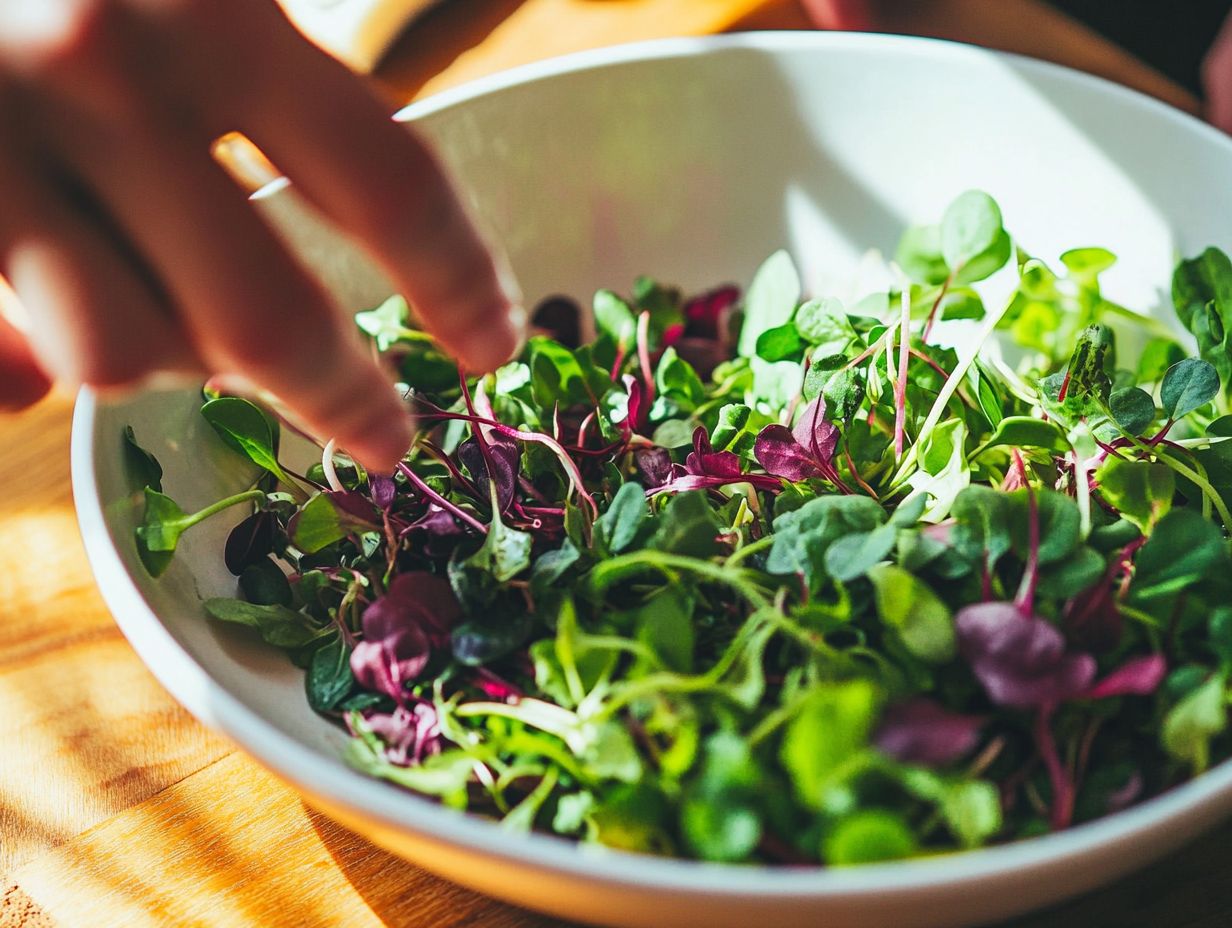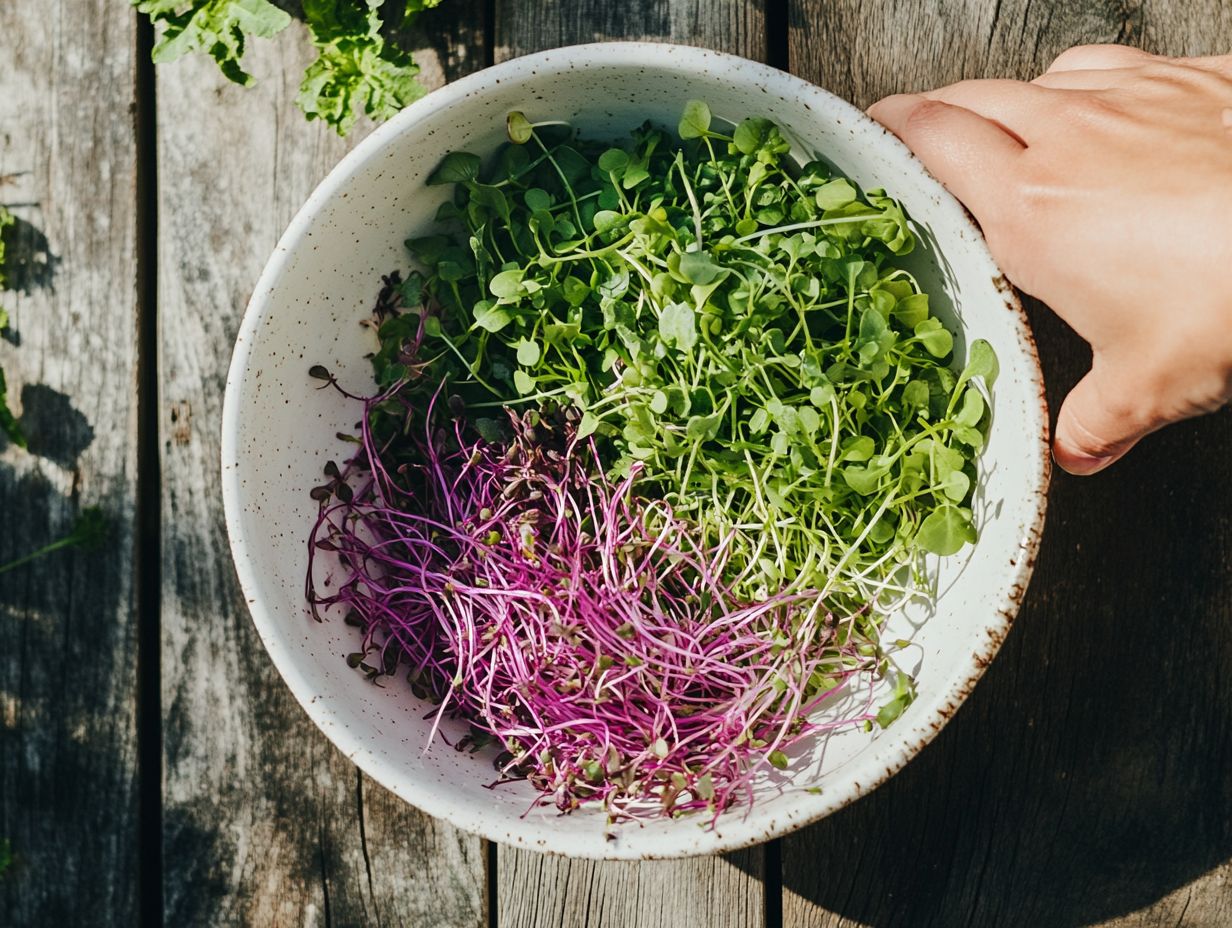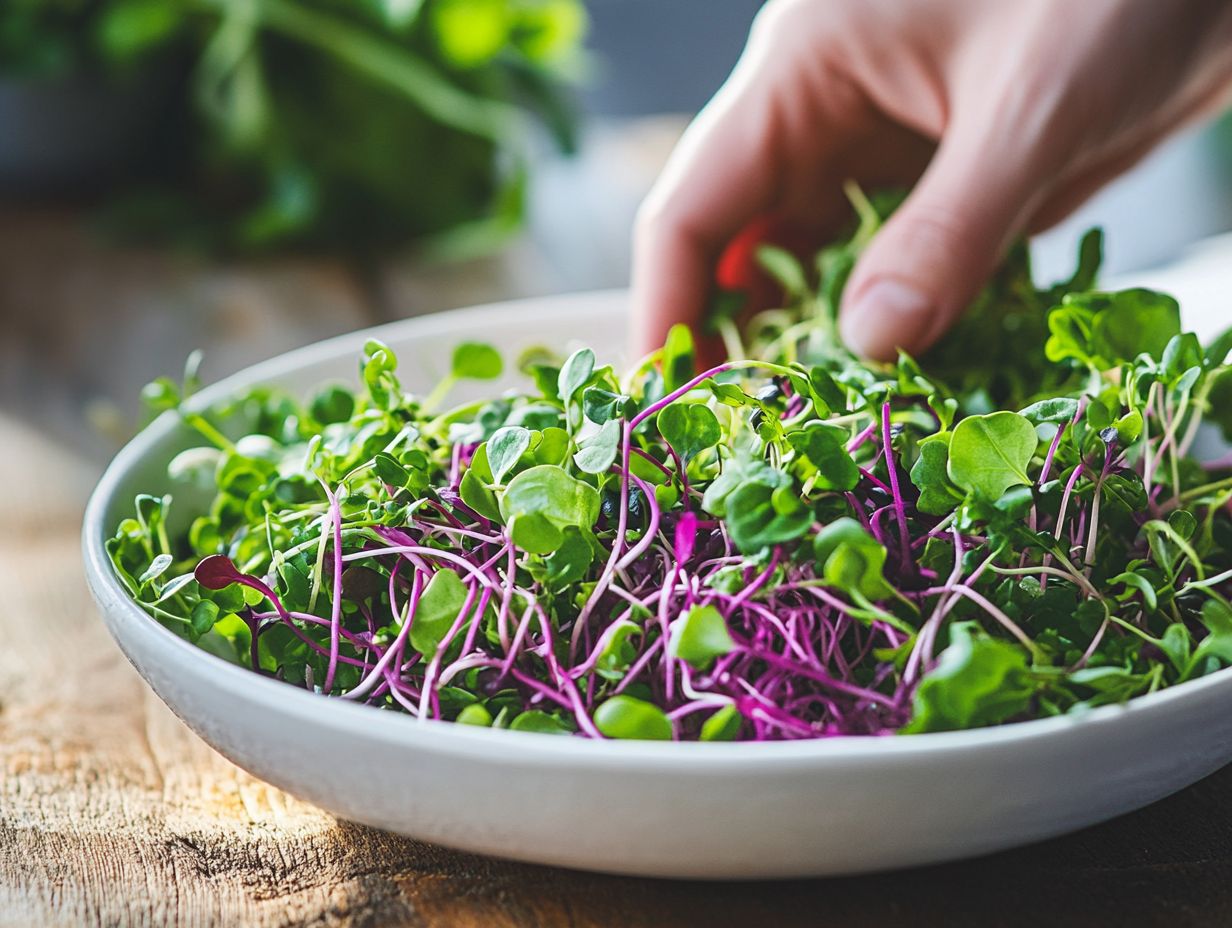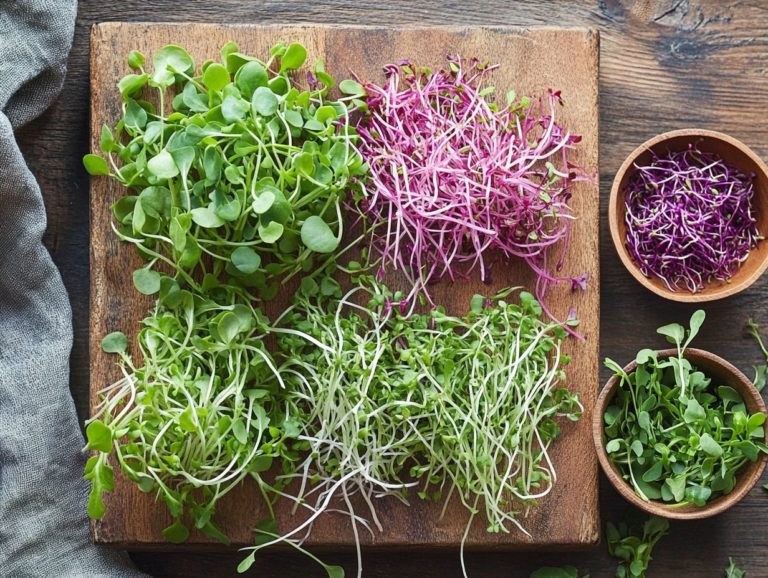The Effects of Microgreens on Health and Wellbeing
Microgreens are tiny, nutrient-rich plants that have taken cooking and health by storm. With their vibrant hues and bold flavors, these miniature greens do more than just beautify your dishes. They pack a serious punch of vitamins and minerals that can elevate your meals.
Explore what microgreens are and uncover their remarkable health benefits like enhancing heart health and giving your immune system a much-needed boost. You will also find simple ways to incorporate them into your meals seamlessly.
You’ll receive valuable tips on growing your own microgreens at home. Discover why these little greens truly deserve a prominent place on your plate!
Contents
- Key Takeaways:
- What are Microgreens?
- Nutritional Benefits of Microgreens
- Health Effects of Microgreens
- How to Incorporate Microgreens into Your Diet
- Growing Your Own Microgreens
- Frequently Asked Questions
- What are microgreens and how are they beneficial for health and wellbeing?
- How do microgreens compare to other types of greens in terms of nutritional value?
- Can microgreens help with weight management?
- Do microgreens have specific health benefits for certain conditions?
- How can microgreens be included in meals for maximum health benefits?
- Do microgreens have any potential side effects?
Key Takeaways:

- Microgreens are young, edible plants that are packed with essential vitamins and minerals, making them a nutritious addition to any diet.
- Including microgreens in your meals can have positive effects on your health, such as improving heart health, boosting the immune system, and reducing the risk of chronic diseases.
- With simple steps for growing microgreens at home and plenty of recipe ideas for incorporating them into meals, it’s easy to reap the health benefits of these tiny greens.
What are Microgreens?
Microgreens are young, edible plants that you harvest right after their first true leaves emerge, displaying a stunning spectrum of flavors, colors, and textures. These nutrient-packed superfoods have surged in popularity, and for good reason they’re brimming with antioxidants, vitamins, and minerals, making them a fantastic addition to your healthy eating habits.
You’ll find common varieties like broccoli, spinach, kale, arugula, peas, Swiss chard, radish, beets, and cabbage, each bringing its own unique culinary applications and health benefits to your table.
Definition and Types
Microgreens are the tiny powerhouses of the plant world, bursting with flavor and nutrients that elevate your healthy diet. Harvested just after the first true leaves emerge, these little greens can be grown from a variety of seeds, including those from leafy greens and cruciferous vegetables.
The beauty of growing microgreens lies in their simplicity; they require minimal space, making them ideal for both indoor and outdoor cultivation. Whether you’re an urban gardener or a culinary enthusiast, these greens are accessible to you.
Popular varieties such as arugula, radish, and basil not only add vibrant colors and unique flavors to your dishes but also pack an impressive nutrient punch often offering higher concentrations of vitamins and minerals than their fully matured counterparts.
Incorporating these delightful microgreens into your salads, sandwiches, or as garnishes will not only enhance the flavor of your meals but also boost their nutritional value. Exploring the role of microgreen varieties in plant-based diets can significantly contribute to your overall health and wellness.
Nutritional Benefits of Microgreens
Microgreens present a wealth of nutritional advantages that position them as an invaluable enhancement to any diet. These petite, nutrient-dense greens serve as a robust source of essential vitamins, minerals, and antioxidants.
Notably, they are rich in vitamin C and vitamin K, as well as an array of phytochemicals, which are natural compounds in plants thought to help prevent disease and promote gut health. Their small stature may be deceiving, yet the profound health benefits they offer make them a superb option for elevating your dietary repertoire.
Vitamins and Minerals Found in Microgreens
Microgreens are celebrated for their impressive nutrient profile. They offer a wealth of vitamins and minerals that enhance your overall health, especially vitamin C and vitamin K.
Take broccoli microgreens, for example. They are brimming with sulforaphane, a natural compound known for helping to fight cancer. Meanwhile, beet microgreens stand out as an outstanding source of dietary fiber, which helps promote digestive health and improves nutrient absorption. Additionally, understanding the impact of water quality on microgreens can further enhance their health benefits.
The abundance of antioxidants in microgreens, including lutein and zeaxanthin, plays a vital role in maintaining eye health, helping to stave off macular degeneration. This tiny powerhouse of nutrients elevates your meals and bolsters your immune system and overall vitality, making microgreens a wise addition to your diet. For those interested in enhancing their nutrition, exploring the top microgreen varieties for health enthusiasts can be incredibly beneficial.
Health Effects of Microgreens

The health effects of microgreens are nothing short of remarkable. They offer a significant boost to heart health, fortify your immune system, and help mitigate the risk of chronic diseases.
By incorporating these nutrient-dense greens into your diet, you can effectively lower cholesterol and blood pressure. They may also play a role in cancer prevention, thanks to their impressive antioxidant content.
Improving Heart Health
Microgreens offer a remarkable boost to heart health. Research indicates that certain varieties can lower cholesterol levels and blood pressure, positioning them as a functional food for your cardiovascular well-being.
Among the standout varieties, broccoli and spinach microgreens are particularly noteworthy. Studies have linked them to substantial reductions in LDL cholesterol, the bad cholesterol that can lead to heart problems. Research published in nutrition journals suggests that incorporating these microgreens into your daily diet can provide vital vitamins and minerals that support heart function, along with a deeper understanding of the role of microgreens in healthy eating.
Adding microgreens to your meals is a fun and delicious way to boost your health! You can toss them into salads, blend them into smoothies, or use them as a topping on whole grain sandwiches. By incorporating these vibrant greens into your plate, you can savor the dual benefits of enhanced flavor and improved heart health.
Boosting Immune System
The immune-boosting properties of microgreens are impressive. Their high antioxidant content and abundant vitamin C work together to enhance your body s natural defenses against infections and diseases.
Particularly, varieties like broccoli and kale microgreens are loaded with sulforaphane, which enhances the body s detoxification processes and activates immune responses. Research shows that regularly enjoying these nutrient-dense greens can lead to reduced inflammation and a stronger immune system.
The rich assortment of vitamins, including A, E, and K, found in microgreens plays a vital role in maintaining optimal immune function.
Whether you toss them into salads, blend them into smoothies, or layer them in sandwiches, these greens not only elevate your culinary experience but also serve as a straightforward yet powerful means to enhance your overall health and reinforce your immunity.
Start your journey to better health today with microgreens!
Reducing the Risk of Chronic Diseases
Microgreens can help reduce the risk of chronic diseases like heart disease and diabetes. Thanks to their impressive levels of natural plant compounds that promote health, including them in your diet acts as a proactive measure for cancer prevention.
Research shows that these nutrient-dense plants contain compounds such as sulforaphane and quercetin. Both of these combat oxidative stress and inflammation, contributing to a healthier cardiovascular system.
The abundance of vitamins A, C, and E bolsters your immune function and may help lower blood sugar levels. This makes microgreens particularly beneficial for those at risk of diabetes.
By adding microgreens to your meals, you enhance your diet and actively reduce your chances of developing debilitating diseases. It’s a smart move toward better long-term health.
How to Incorporate Microgreens into Your Diet
Incorporating microgreens into your meals is simple and delicious. These vibrant greens elevate the flavor, texture, and nutritional profile of your dishes.
You can toss them in salads, layer them in sandwiches, blend them into smoothies, or use them as a garnish. Discover countless effortless recipes that let you enjoy their health benefits.
Recipes and Ideas for Adding Microgreens to Meals

Microgreens can elevate your meals with simple recipes that showcase their flavorful greens. They bring both nutrition and excitement to your daily dishes.
Imagine sprinkling microgreens atop a vibrant vegetable salad for a satisfying crunch or blending them into a refreshing smoothie for an extra nutrient boost. You can also use them as a garnish for soups to elevate your presentation.
Consider adding microgreens to your omelets or quiches for a delicious breakfast twist. You can also use them as a filling in wraps paired with lean proteins for a wholesome lunch.
Their versatility means they fit easily into various cuisines, making them a dynamic ingredient in any recipe sure to impress even the most discerning palates.
Growing Your Own Microgreens
Growing microgreens is a rewarding and remarkably simple endeavor. You can savor fresh, homegrown greens right from your kitchen.
With a wide range of microgreen kits available, even beginners can cultivate nutrient-dense varieties like broccoli, radish, and spinach. This makes gardening accessible and fun for everyone.
Simple Steps for Growing Microgreens at Home
Growing microgreens at home takes minimal space and effort. Follow these straightforward steps to enjoy fresh greens at your fingertips every day!
- Select seeds suitable for microgreens, such as radish, basil, or sunflower.
- Soak the seeds in water for a few hours to kickstart their germination process.
- Prepare a shallow tray filled with quality potting mix, ensuring it drains well while retaining moisture.
- Scatter the soaked seeds evenly across the surface, gently pressing them into the soil, and mist lightly with water.
- Keep the soil damp but not soggy, placing the tray in a warm, bright location.
- In just 7 to 14 days, those tiny greens will be ready for harvest, providing a vibrant and nutritious addition to your meals.
Have you ever thought about growing your own food? It’s easier than you think!
Frequently Asked Questions
What are microgreens and how are they beneficial for health and wellbeing?
Microgreens are young, edible plants harvested at just a few inches tall. They’re full of nutrients and offer various health benefits.
How do microgreens compare to other types of greens in terms of nutritional value?

Studies show that microgreens often have higher concentrations of vitamins, minerals, and antioxidants than fully grown greens. They are harvested at their nutrient peak.
Can microgreens help with weight management?
Yes! Adding microgreens to your diet can be a game changer for weight management. They’re low in calories and high in fiber, helping you feel full longer.
Do microgreens have specific health benefits for certain conditions?
Absolutely! Different microgreens offer unique health benefits. For example, broccoli microgreens have anti-inflammatory properties, while red cabbage microgreens may lower cholesterol.
How can microgreens be included in meals for maximum health benefits?
Microgreens can easily enhance salads, sandwiches, and smoothies. Use them raw or lightly cooked to keep their nutrients intact.
Do microgreens have any potential side effects?
Microgreens are generally safe to eat, but wash them thoroughly to avoid contamination. Those with allergies should consult a healthcare professional before trying specific types.






